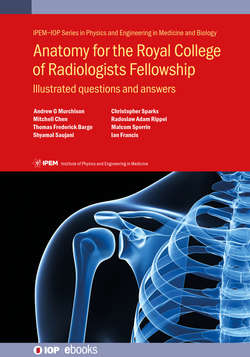Читать книгу Anatomy for the Royal College of Radiologists Fellowship - Malcolm Sperrin - Страница 14
На сайте Литреса книга снята с продажи.
Q1.6 Axial slice from a T2-weighted MRI of the brain
Оглавление1 Name the arrowed structure.
2 Name the arrowed structure.
3 Name the arrowed structure.
4 Name the arrowed structure.
5 Name the arrowed structure.
Answers
1 Left middle cerebellar peduncle.
2 Cerebellar vermis.
3 Right temporal lobe.
4 Right trigeminal nerve.
5 Right optic nerve.
Comments:
The main cranial nerves that are identifiable on cross-sectional imaging and are therefore most likely to appear in the exam are the optic nerve, the trigeminal nerve, the facial nerve and the vestibulocochlear nerve. The trigeminal nerve, which provides sensory input from the face and also innervates the muscles of mastication, arises from the anterior pons. It travels anteriorly through the prepontine cistern and into the trigeminal (Meckel’s) cave, where it forms the trigeminal (Gasserian) ganglion. At this point, it divides into three branches. V1 (the ophthalmic nerve) passes through the cavernous sinus and then the superior orbital fissure. V2 (the maxillary nerve) also passes through the cavernous sinus, and exits the skull through the foramen rotundum. V3 (the mandibular nerve) exits the skull through the foramen ovale.
The optic nerve arises at the retina, and travels posteriorly through the orbit to enter the skull through the optic canal. It then passes through the suprasellar cistern to join with the contralateral optic nerve at the optic chiasm. Nerve fibres then travel in two optic tracts to the lateral geniculate nuclei.
The cerebellar peduncles are three paired white matter tracts that connect the brainstem with the cerebellum. The middle cerebellar peduncles are the largest of these, and connect the pons and cerebellum. The superior and inferior cerebellar peduncles connect the cerebellum with the midbrain and medulla, respectively.
Exam tip:
The trigeminal (Meckel’s) cave isn’t shown on this image, but is a classic exam question—make sure you’re familiar with identifying it on an axial MRI section.
